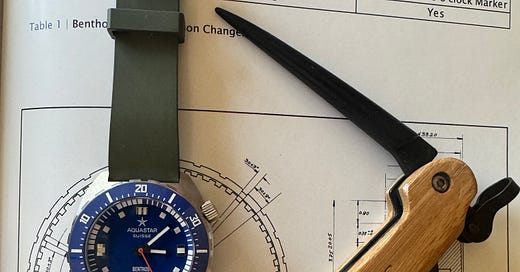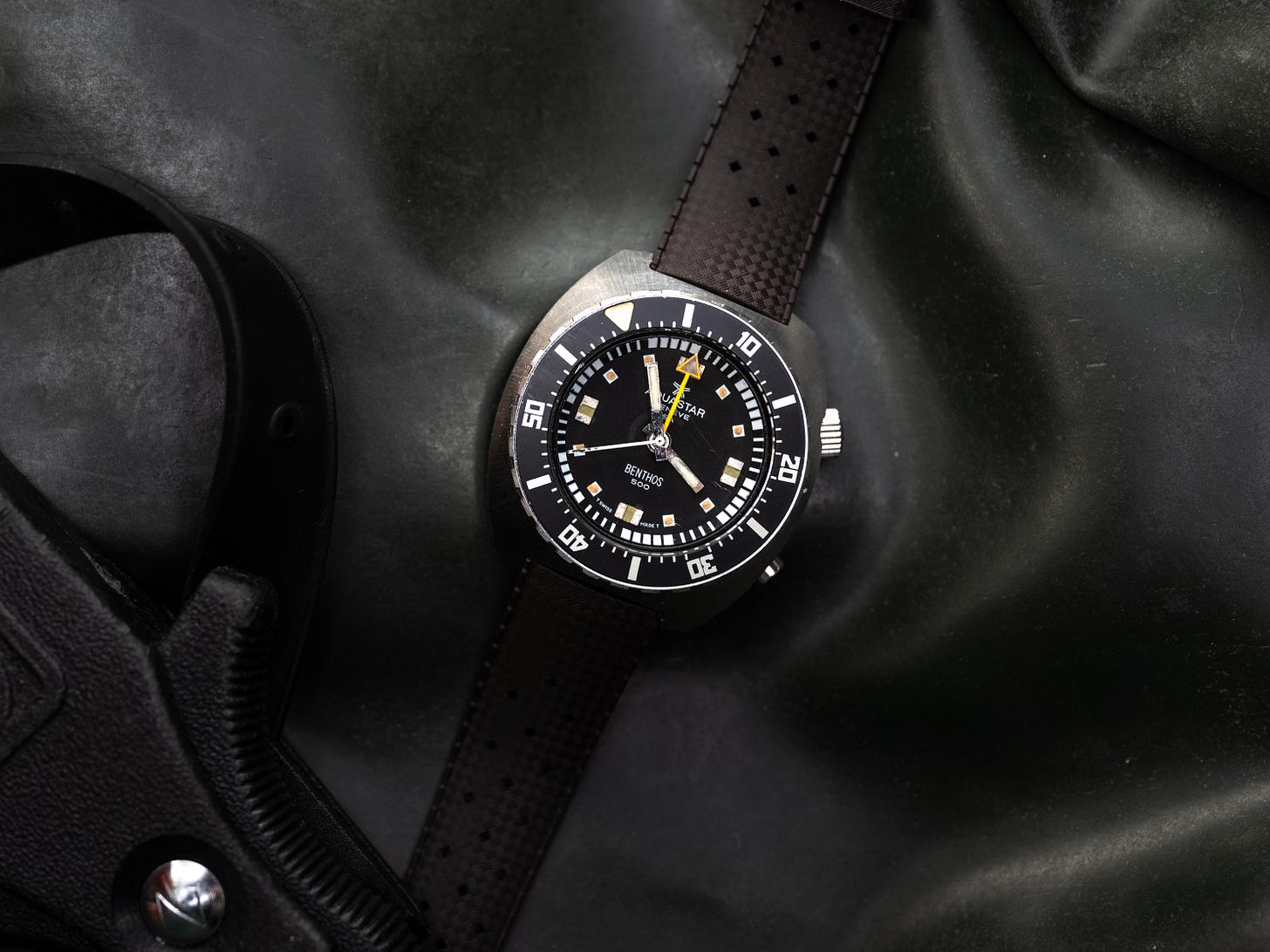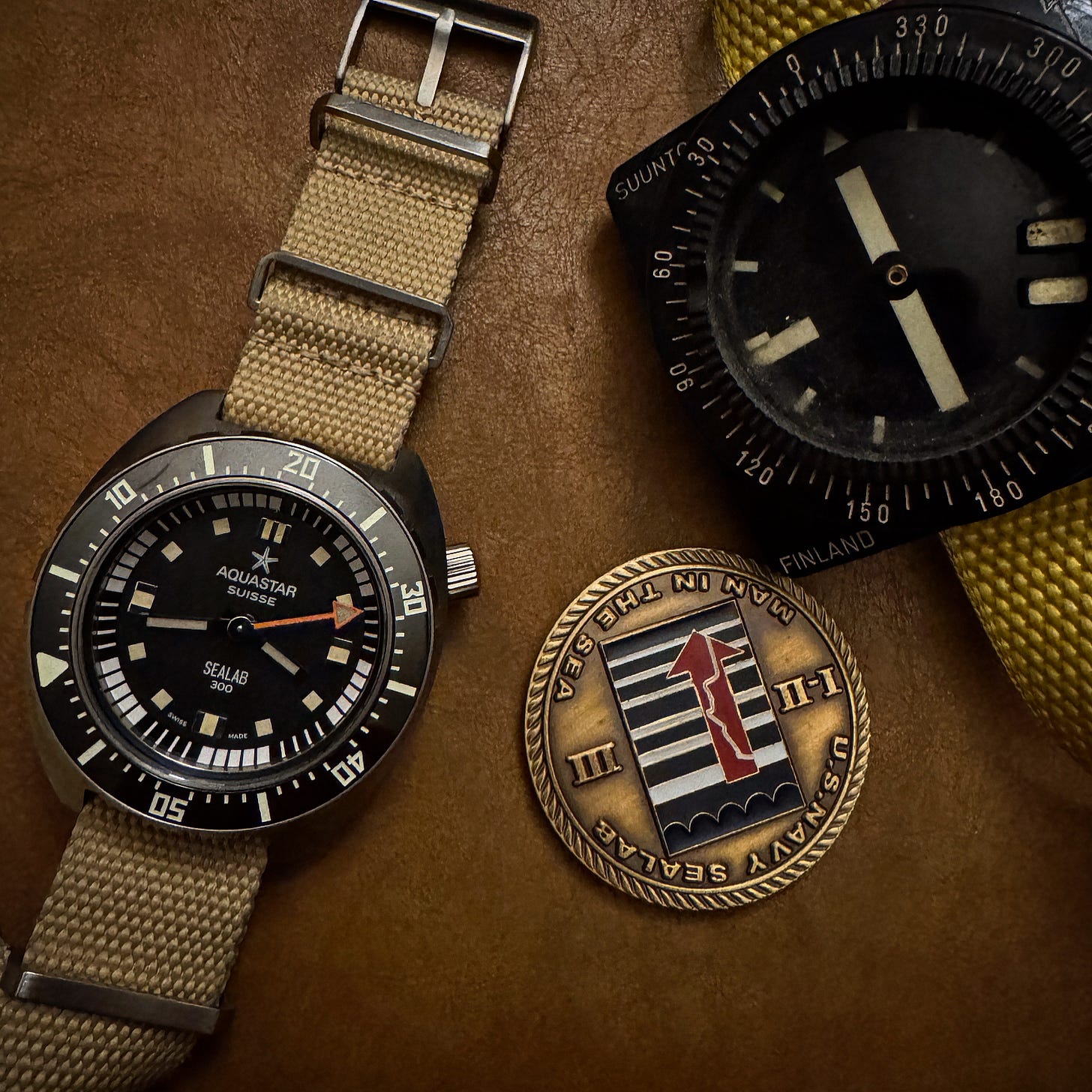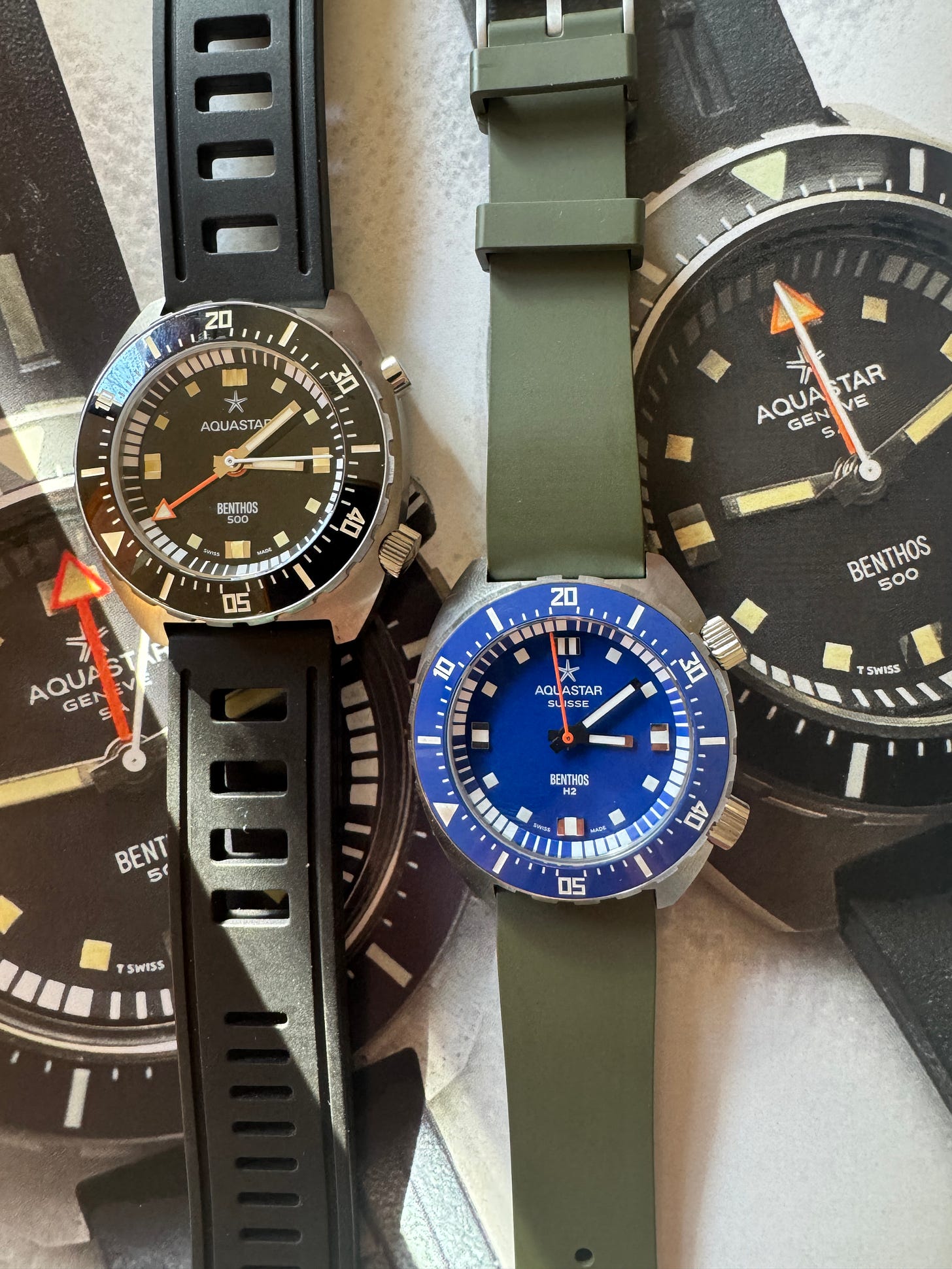“He peered at his wristwatch, a huge, old Aquastar Benthos. It was a gift from his father, who’d worn it during his stint as a support diver on the U.S. Navy’s Tektite project in the early ‘70s. Its timing ring was faded and its case had a dent, but Tusker had faithfully kept it serviced since his father’s death and it never left his wrist.” — Depth Charge
When I set out to write my first novel, I wanted a wristwatch to play a strong supporting role in the story, not in a way that felt forced but as something that bolstered the personality of my main character. I ended up choosing a relatively obscure watch, but one I knew would get nods of approval from readers who knew what it was, and perhaps send others scurrying to search engines to look it up. That watch, an Aquastar Benthos 500, wasn’t even available waaaay back in 2021 when Depth Charge was published. At that time, Aquastar was a recently revived old brand, brought back from a quartz-induced dormancy by industry veteran, Rick Marei. Only one of Aquastar’s historical catalog, the Deepstar chronograph, had been recreated so far. So “literary product placement” wasn’t really a goal of mine with the choice of the Benthos. But I did tell Rick about my choice for the book’s horological hero, and he graciously sent me a restored vintage Benthos (from ca. 1970) to act as some inspiration during my writing, a watch I still treasure and that will always remind me of my first fictional foray.
Readers of Depth Charge now know the ultimate fate of Tusker’s watch, and I won’t spoil it here for those who haven’t read the book. But in the nonfiction world in which we live, the rest of us didn’t have to wait long to get a new Benthos (Greek for “depths of the sea”). To recreate this watch was no small undertaking. The original version was not only remarkable for its extreme water resistance (500 meters) but also unique for its timing complication: a flyback one-hour central minutes chronograph. There simply wasn’t an available movement Aquastar could use for a new version, so it would take time and expense to work with a supplier to develop. While this was being worked on, Aquastar released the Benthos H1 to tide people over, and at a more affordable price. This watch, which was at first glance, a dead ringer for the original Benthos, was time-only, lacking the chronograph functionality. The large orange sweep hand was instead used for the running seconds. Close, but those who wanted the real deal still had to wait. (Side note: the H1 was originally to be called the “SEALAB 300” but ran into trademark issues and thus became the Benthos H1. I happen to have one of the few SEALAB prototypes.)
One thing I’ve wondered about is why it is so difficult to recreate an historic watch movement. After all with modern 3D modeling, CNC machines, and existing movements to use as templates, why a company like ETA, Soprad, or Miyota can’t simply disassemble a defunct movement like the one in the original Benthos and then make a modern version based on it. I’m sure my own ignorance about watchmaking has me overlooking obvious hurdles (cost likely being one of them). Regardless, Rick Marei approached LaJoux-Perret to build him a modern central-minute chronograph. It took years and countless prototypes before the new Benthos 500 was born (oddly, with “only” 300 meters of water resistance). It was an immediate hit, a watch diehard dive watch nerds had been hoping for ever since Aquastar was revived.
I for one have gone on record many times as being a fan of large dive watches. There is something more functional and purpose-built, and instrument-like about a chunky dive watch. As Robert A. Barth, the late Navy diver and SEALAB aquanaut once told me, in his trademark salty fashion, you can always tell a Navy diver in the shower—“big watch, little dick.” I won’t comment on the anatomical reference, but a big watch is a calling card for adventurous types, prized originally for its legibility and ruggedness, now more of an emblem, a talisman, something you see across a room, a dive boat deck, an airplane aisle, and think perhaps its owner might just do cooler stuff than you.
All that said, to many non-purists, the Benthos was simply too big. It sits like a heavy steel ingot on the arm, is unfriendly to sleeves and door frames, and doesn’t suit a wide variety of wrist circumferences. Now, I have had several discussions with Rick about the fickle nature of watch enthusiasts’ tastes around size. I encouraged him to stick to his guns, keep the Benthos big, but then I would be a very bad watch brand owner. Rick is pragmatic, and a businessman as well as a watch enthusiast, and so here we are with a new version of the Benthos that should appease the size conscious: the H2.
The Benthos H2 is noticeably more svelte, a dive watch on an Ozempic prescription. It comes in at an altogether modest 40 millimeters, a diameter often considered the Goldilocks of sports watch sizing. It’s also a sliver under 12 millimeters thick, compared to the Big Mac dimensions of the original Benthos (God bless it), the H1 and modern Benthos 500. On the wrist it wears comfortably, but also presents itself as a bit of an optical illusion. You think it should be massive, and yet… it’s not. Everything about the watch is slightly reduced, in proportion—the bezel, the dial, the text. It’s like looking through the wrong end of a telescope. I actually imagine that, on a smaller wrist, it would be perfect, and carry the same visual impact as the original on a bigger wrist, say, like mine. Personally, I’ll still take the big boy version.
Also new on the Benthos H2 is a helium release valve, something never before seen on a Benthos, or an Aquastar (as far as I know). For those who need a refresher, an “HRV” prevents overpressure inside a watch case by allowing the buildup of helium atoms to harmlessly escape without blowing off the crystal or damaging the movement. It was developed for saturation divers who spend extended periods inside pressurized helium rich hyperbaric chambers between periods of working at great depths. In other words, utterly irrelevant for most of us. I used to be fairly pedantic about HRVs, decrying their appearance on so many dive watches. But I’ve softened my opinion in recent years, and own several dive watches with them. Yes, they are needless complexities that will never get used, but for a company to build a watch it touts as a true professional instrument, it represents a no-holds-barred, kitchen sink ethos. In the case of the Benthos H2, it is incorporated into a crown at 4:00. This means it is a manually actuated HRV and not an automatic spring loaded one. That may seem counterintuitive—after all, a diver would have to remember to unscrew that crown during decompression—but I’ve come to recognize it as a point of visual interest, a conversation piece, that will stay tightly shut for most of its existence, until one finds oneself trapped, under pressure, inside the hyperbaric chamber aboard a villain’s dive support vessel (cf. Depth Charge).
The prototype Benthos H2 that Aquastar sent me happens to be of a color that will not be produced. It’s a rather bright shade of blue, not the pleasing darker royal blue found on some vintage Aquastars. It came mounted on a matching blue Tropic strap, but it was simply too much for my eye, so I quickly moved it onto a more complementary strap, and somehow that toned down the blue to a more acceptable hue. Will we see future Benthoses(?) with blue dials (there is a blue H1) and bezels? Perhaps other colors? How about a DLC black or gunmetal case? A diver can dream…
I’m not a specs guy, and you can find all the details on Aquastar’s website, but one that is significant, particularly at the $1200 price point, is the use of 904L stainless steel. Until recently, this highly corrosion resistant alloy was used by Rolex and almost no one else, 316L being the common form of steel. But more and more brands are opting for 904L. It’s similar, in a way, to the way titanium has trickled down to many more—and more affordable—brands. I doubt most of us could tell the difference in real world wear, but it’s yet another example of a commitment to quality that Aquastar has made with this line of watches.
The Benthos to me is in the pantheon of great, true diver’s watches, alongside the Rolex Sea Dweller, the Omega Ploprof, and the Seiko “Tuna,” albeit lesser known than all of those. My love is considerable for watches that were developed in an era when deep diving was akin to space travel, when so much was unknown, and dangers abounded. The Benthos was unapologetically quirky and big, built for a function without compromise by a company that only made watches for use in, and under, water. To find complaint with it now is largely a moot point. This was not a watch designed for modern desk divers taking Instagram wrist shots. And yet, times do change, divers don’t wear watches much any more to track their no-decompression, and decompression, times. Enthusiasts want to channel the derring-do of those who wore them for countless exploits under the waves, but perhaps want something they can wear to the waterpark with their kids, or on a snorkeling holiday. And thus, Aquastar, and the Benthos continue to evolve, not unlike the countless other creatures that exist in the depths of the sea.








